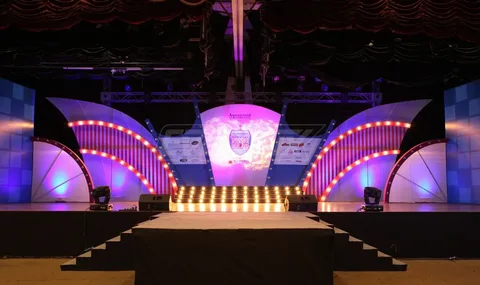Creating a memorable event requires more than just a great lineup of performers or speakers. The visual and atmospheric elements play a pivotal role in captivating your audience and setting the tone for an unforgettable experience. Among these elements, stage design and rigging stand out as critical components that elevate event ambience. From corporate conferences to music festivals, these aspects transform a venue into an immersive environment that resonates with attendees. In this blog, we’ll explore how stage design and rigging enhance your event’s atmosphere, engage your audience, and leave a lasting impression.
The Power of Stage Design in Setting the Mood
Stage design is the foundation of your event’s visual appeal. It’s the canvas where your theme, brand, or story comes to life. A well-crafted stage design aligns with your event’s purpose, whether it’s to inspire, entertain, or educate. Here’s how it enhances ambience:
1. Creates a Visual Focal Point
The stage is where all eyes are drawn during an event. A thoughtfully designed stage captures attention and guides the audience’s focus. For instance, a sleek, minimalist stage with LED screens can create a modern, professional vibe for a tech conference, while vibrant colors and dynamic props can energize a concert setting. By incorporating lighting, textures, and multimedia, stage design ensures the audience remains engaged.
2. Reinforces Brand Identity
For corporate events or product launches, stage design is an opportunity to showcase your brand. Custom backdrops, logo placements, and color schemes that reflect your brand identity create a cohesive experience. This subtle reinforcement builds trust and leaves a professional impression on attendees.
3. Sets the Emotional Tone
The stage’s aesthetic influences how the audience feels. A warm, intimate setup with soft lighting and draped fabrics can evoke a sense of connection at a wedding or gala, while bold, futuristic designs with sharp angles and neon lights can generate excitement at a music festival. By aligning the stage with your event’s emotional goals, you create an ambience that resonates deeply.
The Role of Rigging in Elevating Event Ambience
Rigging, the technical process of suspending equipment like lights, speakers, and props above the stage, is often overlooked but equally vital. Professional rigging ensures safety, functionality, and creativity, allowing you to push the boundaries of your event’s atmosphere. Here’s how rigging enhances your event:
1. Enables Dynamic Lighting
Lighting is a game-changer in creating ambience, and rigging makes it possible to position lights strategically. Suspended lighting fixtures can shift colors, intensities, and patterns to match the mood of each moment—whether it’s a dramatic spotlight for a keynote speaker or a pulsating light show for a DJ set. Rigging allows for flexibility, ensuring lights are placed exactly where they’re needed to maximize impact.
2. Supports Immersive Audiovisuals
From massive LED screens to projection mapping, rigging enables the seamless integration of audiovisual elements. These technologies create immersive experiences, such as displaying live feeds, animations, or branded content above the stage. For example, a concert might use rigged screens to project close-ups of performers, making even the back rows feel connected to the action.
3. Facilitates Creative Installations
Rigging opens the door to jaw-dropping installations that elevate your event’s wow factor. Suspended sculptures, chandeliers, or even floating stages can transform a venue into a spectacle. These elements not only enhance aesthetics but also spark conversations, making your event shareable on social media. For unique rigging solutions, you can visit website of professional event production companies to explore innovative ideas tailored to your vision.
How Stage Design and Rigging Work Together
The magic happens when stage design and rigging are seamlessly integrated. A cohesive approach ensures that every element—lighting, props, audiovisuals, and stage layout—works in harmony to amplify your event’s ambience. Here’s how they complement each other:
1. Enhances Storytelling
Events often tell a story, whether it’s a brand narrative, a musical journey, or a cultural celebration. Stage design sets the scene, while rigging brings it to life with dynamic effects. For instance, a theater production might use a rustic stage set with rigged spotlights and moving props to transport the audience to another era.
2. Maximizes Space
Venues come in all shapes and sizes, and stage design paired with rigging optimizes the available space. Rigging allows you to utilize vertical space, freeing up the stage for performers or presenters. This is especially crucial for smaller venues, where creative rigging solutions like truss systems can make a compact stage feel grand.
3. Ensures Safety and Reliability
Professional rigging ensures that all suspended elements are secure, allowing stage designers to focus on creativity without compromising safety. This reliability gives event organizers peace of mind, knowing that the ambience-enhancing features will perform flawlessly.
Practical Tips for Optimizing Stage Design and Rigging
To make the most of stage design and rigging, consider these actionable tips:
- Collaborate with Professionals: Work with experienced event production teams who specialize in stage design and rigging. They can bring your vision to life while ensuring safety and efficiency.
- Plan Early: Start designing your stage and rigging setup well in advance to account for logistics, permits, and custom installations.
- Consider Your Audience: Tailor the design to your audience’s preferences. For example, younger crowds may appreciate bold, tech-driven visuals, while corporate attendees may prefer a polished, professional look.
- Test Everything: Conduct thorough rehearsals to ensure lighting, audiovisuals, and rigged elements sync perfectly with the event flow.
- Stay Sustainable: Opt for eco-friendly materials and energy-efficient lighting to create an ambience that’s both stunning and responsible.
Conclusion
Stage design and rigging are the unsung heroes of event planning, transforming ordinary venues into extraordinary experiences. By combining creative stage aesthetics with technical rigging expertise, you can craft an ambience that captivates, inspires, and leaves a lasting impression on your audience. Whether you’re hosting a small seminar or a large-scale festival, investing in these elements will elevate your event to new heights. Partner with professionals, plan strategically, and let stage design and rigging work their magic to create an unforgettable atmosphere.

